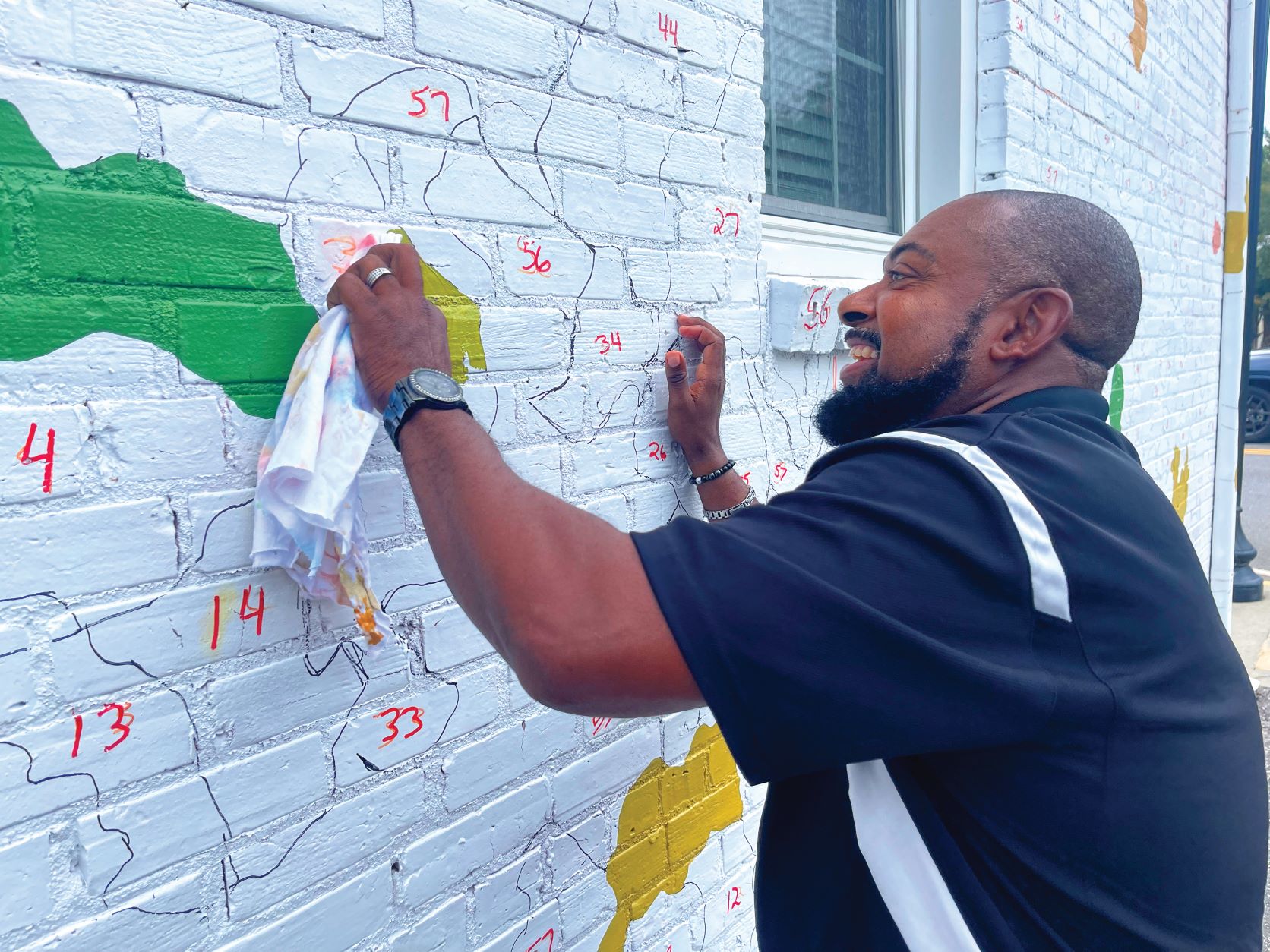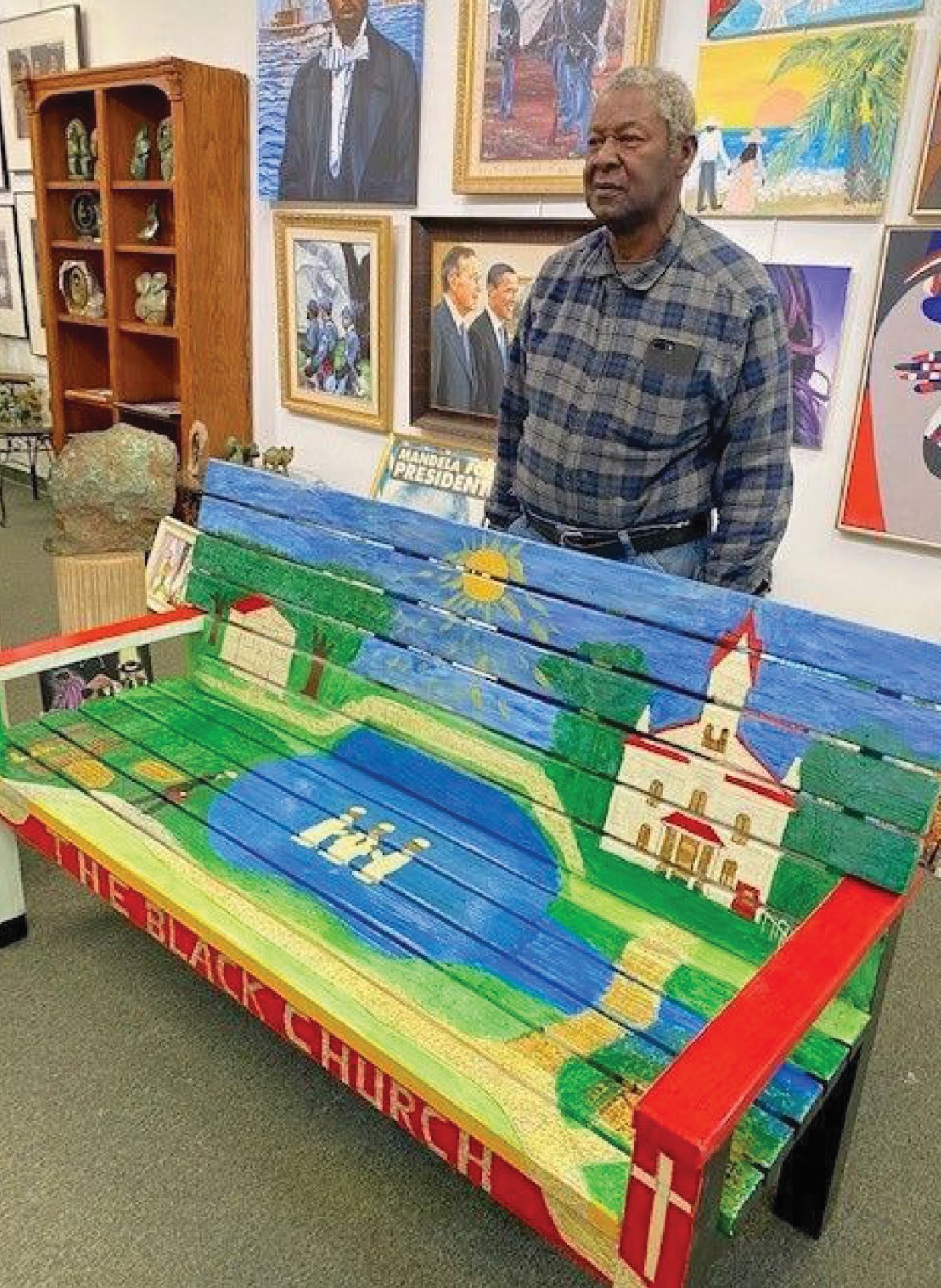City-sponsored art is about more than making buildings, buses and byways look better. It’s about creating a sense of place — where people come from, what they’ve been through and how they see themselves.
Creating an artistic representation of a town’s identity is a low-cost way to build a sense of community among residents. When cities purse projects creatively, they can find unexpected places for art to appear, and can even establish an entirely new attraction for tourists to visit.
Paint by numbers
In downtown Conway, a new city-employee-created mural is adding to the local identity. All 315 of the city’s employees worked on the mural, filling individual sections of it in with paint
“It started with a photograph,” said Mary Catherine Hyman, deputy city administrator. “The fire chief took a photograph of the Main Street bridge and from there the city administrator took the photograph and made it look more impressionistic. I converted it to a paint-by-numbers [project].”

A paint-by-numbers plan allowed all Conway staff employees to easily
get involved in the mural-painting process. Photo: City of Conway.
The effort took about a month and many late nights. In the end, it brought employees together and gave each painter a feeling of ownership of the portion they painted.
“It seemed insurmountable when we started. People would come on their lunch hour or at night. It was exciting and thrilling to them,” said Hillary Howard, executive director Conway Downtown Alive. “I think it’s really important that employees feel like they play an important role in the city. We want them to take ownership of their place of employment and to showcase talents they didn’t even realize they had.”
The paint for the project — about 100 gallons in 60 different colors — was a donation from a local paint store. As the image emerged, residents didn’t know what the completed mural would depict. It became a talking point on social media as observers tried to guess the subject matter.
Now, the mural — one of several in downtown — has become a photo destination for residents and visitors alike.

City of Conway staff join the ribbon cutting for their downtown mural,
painted entirely by employees. Photo: City of Conway.
“Different departments got to work together that don’t really spend a lot of time with each other,” Hyman said. “We discovered some artists we didn’t know we had, and as we were painting the public would stop and ask questions. We love it now because you see so many folks stopping by to take photos.”
Welcome to Beaufort, have a seat
The City of Beaufort aimed to expand the availability of places for people to sit while enjoying the natural beauty of the historic port city. It involved its public art program in the process, so that the seating could double as artwork that told Beaufort’s story.
“One of the things our convention and visitors bureau mentioned in surveying tourists, they wanted places to sit,” said Downtown Manager and Events Coordinator Andrea Hackenberger. “So we thought of places where the bench could highlight an attraction or a point of history.”

The Rev. Johnnie F. Simmons painted a bench celebrating the
historic Tabernacle Baptist Church, one of the initial works of the
Beaufort Cultural District’s Bench Project.
Photo: City of Beaufort.
The first phase of six benches were built by Beaufort’s local Habitat for Humanity with materials — costing about $400 for each bench — provided by the Cultural District advisory board. Next, the project asked local attractions to sponsor a bench, and those sponsors contracted individually with the artists to paint them.
“The artists have been so creative in telling the story of what makes Beaufort, Beaufort,” Hackenberger said.
The city located each of the finished benches near the sponsoring attraction. The biggest hurdle was finding locations that were also not in a SC Transportation Department right of way, which is often where the sponsors wanted to put them. The benches are now mostly placed on private property.
The second phase brought another six benches. Now in its third — and likely final — phase, the city is again reaching out to find sponsors for the popular benches.
“People love the locations we’ve placed the benches,” Hackenberger said. “The one on the bluff is probably the best location because it looks onto the river.”
She added that a local resident who enjoyed the program decided to sponsor that bench.
Connecting trash and artistic treasure
Of the City of West Columbia’s many pieces of public art, one of its most popular has been its project of taking something not known for its beauty — the fleet of sanitation trucks — and covering them with the works of local artists.
“Before we started the [city’s] rebranding process, we had discussed having artists put paintings on sanitation trucks, but we couldn’t have them down that long,” said Kelli Ricard, director of events and publications for the city.
The city came up with a compromise. It would commission art — at $2,000 a piece — from local artists, not painted directly on the trucks, that would then be transferred onto wraps that could be installed on the trucks quickly.

West Columbia used vehicle wraps to apply locally created artwork
on their garbage trucks. Photo: City of West Columbia.
“We actually gave the artists the size of the area that the art would cover on the truck and asked them to create artwork that was proportionate to the finished size, and up to 4 feet long,” Ricard said. “We wanted the larger size art to provide the best definition for the final product, and to be able to hang the [original] art at city hall.”
The wraps, made by a local company, are guaranteed for five years and can be cleaned of anything a sanitation truck can throw at it, including graffiti.
“You can clean it with bleach and it will stay on,” Ricard said. “It’s also reflective, which helps with the safety aspect of it.”
The installation of the artwork was less than $3,000 per truck and came out of the sanitation budget, as the trucks were going to be rebranded anyway.
The public response to the trucks has been even better than expected, Ricard said.
“One of the ideas is that we wanted residents to interact with sanitation workers in a positive way, and have them have a conversation about what was on the truck and why was it there, instead of just about picking up garbage,” she said. “The reception has been awesome. Our guys, who were already good at communicating with our residents, had something else positive to talk about.”
Residents have sent videos to the city or posted them on social media when they spot a truck around it.
“Many say on social that it puts on a smile on their face,” Ricard said.
The trucks include a QR code that people can scan with their phones to take them to online content with more information about the artists and their work.
The trucks are just one piece of the public art puzzle for West Columbia, which is planning a sculpture in the area known as Triangle City. The sculpture will replace an aging fountain that needs repairs.
“I think that more art that we have installed, the more residents realize they enjoy it and like having it here,” Ricard said. “It’s becoming more and more important than they realized it would be. And we have a lot of artists who live in West Columbia … If you incorporate those local artists and local companies, the buy-in is even better and helps people relate to what you are pushing out.”
When cities find a new and unusual canvas for their public art, they are not just celebrating local artists and local character — they are also finding a new way to engage their residents and visitors.
